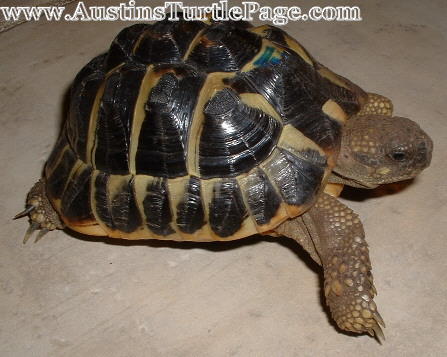|
Western Hermann's Tortoise |
By Jan O.
 |
 |
|
Pic courtesy of Evan D |
Testudo hermanni hermanni
Upto 4" - 8"
Hermanns tortoises
are herbivores and in the wild consume a wide variety of flowers, leaves, and
plant stalks. Their natural diet is high in fiber and calcium, and low in
protein and fat.
Daytime Air Temperature:
70-90°
Nighttime Air Temperature:
60-65°
Basking Temperature:
90-95°
Humidity:
30-50%
Preferred
is Mediterranean oak forest, arid, rocky hillslopes with scrubby
vegetation.
Northeastern Spain, southern France,
northwestern Italy, and several Mediterranean islands.
Yes
If possible, a
safe and secure outdoor habitat with plenty of sun is preferred, and it should
be planted with a variety of edible weeds, wildflowers, and a little bermuda
grass. A southern exposure for basking, and bushes and rocks for hiding will be
greatly appreciated. If an indoor habitat is used, it should mimic an outdoor
one as much as possible.
Adults and even babies should be
outdoors, if the enclosure is safe from predators, including birds. For an
adult, about 6'x4' should be enough, but the bigger the better. If you house
more than one hermanns tortoise together, the enclosure must be larger. Hermanns
tortoises are active and will dig and climb, especially if their pen is too
small. To prevent escapes, make sure the pen's walls are placed several inches
below ground surface and either makes the walls high or place a lip along the
top of the wall to discourage climbing.
For a hatchling's indoor enclosure, a
rubbermaid container filled with a mixture of organic soil, orchid bark, and
play sand makes a nice habitat. Form some hills in the dirt, put in a few
rocks, and place a seed tray in one corner to grow some sedum, weeds, and
wildflowers. You can also accommodate an adult in a similar, but larger,
rubbermaid container. Indoor enclosures need to have UVB light from a bulb,
such as a Reptisun 5.0. You will also need a heat lamp for a basking area and a
hide box for some privacy. Mercury vapor lamps, which supply heat and UVB, are
good as long as the enclosure offers a warm end and a cooler end.
Clean water should be available
daily, and twice-weekly soaks are not a bad idea, either. Hermanns tortoises
kept outdoors will often make a point of coming out during a rainstorm and
drinking from puddles!
The best diet is a natural one that
allows the tortoise to graze on various weeds and greens. Such things as
dandelion, bindweed, opuntia cactus, sedum, plantains (the weed, not the fruit
known as plaintain), coreopsis, hibiscus, mulberry leaves, California poppy,
mallow, honeysuckle, some vetches, some clovers, bermuda grass, and many other
wildflowers and weeds can be grown in an outdoor tortoise pen. It is also
possible to grow many wildflowers and weeds indoors and in greenhouses so that
your tortoise does not have to rely on grocery store greens, especially in
winter. Anything the tortoise might graze on must be pesticide free.
If fed grocery store produce, it
should be mixed into a salad and may include endive, escarole, shredded carrot,
kale, opuntia, occasional romaine, and occasional pumpkin. The mixed salad diet
is low in fiber so it is helpful to sprinkle with bermuda grass hay that has
been ground to a powder (a coffee grinder works well). Dust the food with
calcium daily, and if the tortoise isn't kept outdoors in natural sunlight, also
use a combination calcium-D3 product a couple of times a week. It is also
helpful to keep a cuttlebone (with the back removed) in the enclosure so your
tortoise can nibble on it if she or he feels the need for more calcium.
Foods to avoid (or to use in very
*tiny* amounts) because they interfere with the uptake of calcium: spinach,
broccoli, brussels sprouts, cabbage, beans, peas, cauliflower, collard greens,
beet greens, turnip greens, mustard greens. Fruit also should be avoided
because the hermanns tortoise's digestive system can't process it.
Do NOT house males together as they
may fight. Females may be housed together, as well as a male and 2-3 females.
Males are aggressive so keeping one male and one female together is not
recommended, although it may work fine in some cases. Hermanns tortoises don’t
get "lonely" so they don't necessarily need company.
Other Information: The Hermanns
tortoise is a beautiful species of tortoise. They are very hardy, stay small,
and are quite friendly. There are two subspecies, Western and eastern. The
eastern hermanns (Testudo hermanni boettgeri) get a little bigger and are much
more common than the Westerns (Testudo hermanni hermanni).